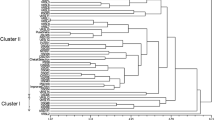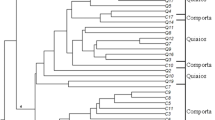Abstract
The objective of this study was the evaluation of molecular and morphological diversity among 80 caper (Capparis spinosa L.) genotypes from the 12 regions of the central Zagros Mountains located in the west of Iran. The results showed a high level of morphological genetic variation among the caper samples. According to the morphological cluster analysis, 80 genotypes were clustered into five main groups. The 15 factors justified 78.7% of the total variation based on factor analysis. ISSR primers produced a total of 108 polymorphic bands (85.04%) from 127 bands and the PIC for primers ranged from 0.02 to 0.33. SCoT primers produced a total of 165 polymorphic bands (86.48%) from 190 bands and the PIC for primers ranged from 0.16 to 0.30. Ordination and cluster analysis by ISSR markers showed that the genetic relationships among all accessions could be separated into three major groups and by SCoT markers separated into six groups. The results did not show a perfect match between the molecular diversity groupings and geographical regions, because many natural factors and human activities shape the amount and pattern of genetic diversity in a plant population. SCoT and ISSR markers for the assessment of genetic diversity of caper germplasm were almost identical. The combined (ISSR + SCoT) markers haven't shown more information on genetic diversity than a single analysis of ISSR and SCoT. The results indicated the existence of dispersion and different levels of morphological variation and molecular genetic diversity in the genotypes collected from the west of Iran.












Similar content being viewed by others
References
Abdi H, Williams LJ (2010) Principal component analysis. Wiley Interdiscip Rev: Comput Stat 2(4):433–459
Ahmadi M, Saeidi H (2018) Genetic diversity and structure of Capparis spinosa L. in Iran as revealed by ISSR markers. Phys Mol Biol Plants 24(3):483–491
Al- Safadi B, Faouri H, Elias R (2014) Genetic diversity of some Capparis L. species growing in Syria. Braz Arch Biol Technol 57(6):916–926. https://doi.org/10.1590/S1516-8913201402549
Ali S, Kumar S, Saxena SN, Sharma R, Singh PK, Singh G (2014) Assessing biochemical and molecular diversity in Ker (Capparis decidua): A multipurpose shrub of Thar desert. Int J Seed Spices 4(2):53–61
Aliyazicioglu R, Eyupoglu OE, Sahin H, Yildiz O, Baltas N (2013) Phenolic components, antioxidant activity, and mineral analysis of Capparis spinosa L. Afr J Biotechnol 12(47):6643–6649
Anonymous (1999). The ayurvedic pharmacopoeia of India. Part-1. 1st ed., Vol. V. Kottakkal: Arya Vaidya sala. p. 41.
Babili Jr, M (2015) Benefiting commercially from untapped plant natural resources: Caper as a case study. No. 1104–2016–91738
C Bertrand Collard & David Y, Mackill J, 2009 Start Codon Targeted (SCoT) polymorphism: A simple, novel DNA marker technique for generating gene-targeted markers in plants Plant Mol Biol Rep 27 86 93 https://doi.org/10.1007/s11105-008-0060-5
Bhoyar MS, Mishra GP, Naik PK, Ashutosh A, Murkute RB (2012) Genetic variability studies among natural populations of Capparis spinosa from cold arid desert of Trans-Himalayas using DNA markers. Natl Acad Sci Lett 35(6):505–515
Doyle JJ, Doyle JL (1987) A rapid DNA isolation procedure for small quantities of fresh leaf tissue. PhytochemBull 19:11–15
Errachidi F, Bour A, Bouhaddaoui S, Chabir R (2019) Morphological and nutritional properties of Moroccan Capparis spinosa Seeds. The Scientific World Journal 2019.
Fakhri M, Bakhshi Khaneki GR, Sadeghi SM (2008) Investigation of ecological characteristics of blind species (Capparis spinosa L.). Res Form Nat Res 80:169–175
Fici S, Gianguzzi L (1997) Diversity and conservation in wild and cultivated Capparis in Sicily. Bocconea 7:437–443
Gristina AS, Fici S, Siragusa M, Fontana I, Garfi G, Carimi F (2014) Hybridization in Capparis spinosa L.: molecular and morphological evidence from a Mediterranean island complex. Flora 209:733–741. https://doi.org/10.1016/j.flora.2014.09.002
Hou YC, Yan ZH, Wei YM, Zheng YL (2005) Genetic diversity in barley from west China based on RAPD and ISSR analysis. Barley Genetics Newsl 35(1):9–22
Inocencio C, Cowan ARS, Alcaraz F, Rivera D, Fay MK (2005) AFLP finger-printing in Capparis subgenus Capparis related to the commercial sources of capers. Genet Resour Crop Evol 52:137–144
Inocencio C, Rivera D, Obón MC, Alcaraz F, Barreña JA (2006) A systematic revision of capparis section Capparis (Capparaceae) 1, 2. Ann Mo Bot Gard 93(1):122–149
Jaccard P (1908) Nouvelles recherche´ sur distribution florale. Bull Soc Vaud Sci Nat 4:223–270
Kimura M, Crow JF (1964) The number of alleles that can be maintained in a finite population. Genetics 49(4):725–738
Kumar S, Sharma R, Kumar V, Vyas GK, Rathore A (2013) Combining molecular-marker and chemical analysis of Capparis decidua (Capparaceae) in the thar desert of western Rajasthan (India). Rev Biol Trop 61(1):311–320
Lansky EF, Paavilainen HM, Lansky Sh (2014) Traditional herbal medicines for modern times. Int Stand Book Number 13: 978–1–4398–6138–7.
Legendre P, Fortin MJ, Borcard D (2015) Should the mantel test be used in spatial analysis? Methods Ecol Evol 6(11):1239–1247
Lewontin RC (1972) The apportionment of human diversity. Evol Biol 6:381–398
Liu C, Xue GP, Cheng B, Wang X, He J, Liu GH, Yang WJ (2015) Genetic diversity analysis of Capparis spinosa L. populations by using ISSR markers. Genet. Mol. Res 14 (4): 16476–16483.
Manikandaselvi S, Vadivel V, Brindha P (2016) Review on ethnobotanical studies of nutraceutical plant: capparis spinose (caper). Asian J Pharm Clin Res 9(3):123–126
Mansour RB, Jilani IBH, Bouaziz M, Gargouri B, Elloumi N, Attia H, Ghrabi-Gammar Z, Lassoued S (2016) Phenolic contents and antioxidant activity of ethanolic extract of Capparis spinosa. Cytotechnol 68(1):135
Martín JJ, Saadaoui E, Cervantes E (2016) Seed shape quantification in capparis spinosa L: effect of subspecies and geographic regions. SCIREA J Agric 1(1):79–90
Matsuyama K, Villareal MO, El Omri A, Han J, Kchouk ME, Isoda H (2009) Effect of tunisian Capparis spinosa L. extract on melanogenesis in B16 murine melanoma cells. J Nat Med 63(4):468
Moubasher H, Abd El-Ghani MM, Kamel W, Mansi M, El-Bous M (2011) Taxonomic considerations among and within some Egyptian taxa of Capparis and related genera (Capparaceae) as revealed by RAPD fingerprinting. Collect Bot 30:29–35. https://doi.org/10.3989/collectbot.2011.v30.003
Muharrem G, Gürsel Ö, Sezai E (2009) Caper (Capparis spp.) growing techniques and economic importance. 1st International Syposium on Sustainable Development 9–10.
Musallam I, Duwayri M, Shibli R (2010) Morphological diversity of Capparis spinosa L. Jordan Pharm Mag 6(22):158
Musallam I, Duwayri M, Shibli R, Alali F (2012) Investigation of rutin content in different plant parts of wild caper (Capparis spinosa L.) populations from Jordan. Res J Med Plant 6(1):27
Nabavi SF, Maggi F, Daglia M, Habtemariam S, Rastrelli L, Nabavi SM (2016) Pharmacological effects of Capparis spinosa L. Phytother Res 30:1733–1744
Nikkerdar F, Farshadfar M, Ebrahimi MA, Shirvani H (2018) Genetic diversity among fennel (Fueniculum Vulgare Mill) landrace using scot markers. J Crop Breed 9(24):95–102
Nosrati H, Feizi MAH, Mazinani M, Haghighi AR (2012) Effect of population size on genetic variation levels in Capparis spinosa (Capparaceae) detected by RAPDs. Eur Asian J Biol Sci 6:70–75. https://doi.org/10.5053/ejobios.2012.6.0.8
O¨zbek O, Kara A (2013) Genetic variation in natural populations of Capparis from Turkey, as revealed by RAPD analysis, Plant. Syst. Evol. 299 (10). https://doi.org/10.1007/s00606-013-0848-0.
Omidbaigi R (2005) Production and processing of medicinal plants. Tehran University 283p. (In Persian).
Oscar GL, Carlos P, Zsuzsanna G et al (2014) Genetic variation of the endangered Gentiana lutea L. var. aurantiaca (Gentianaceae) in populations from the Northwest Iberian Peninsula. Int J Mol Sci 15:10052–10066
Patel V, Sharma V, Patidar A (2014) Quantitative analysis of rutin and quercetin in Capparis spinosa and brassica oleracea by HPLC. Int J Pharm Life Sci 5(8):3720
Peakall R, Smouse PE (2006) GENALEX 6: genetic analysis in Excel. Population genetic software for teaching and research. Mol Ecol 6:288–295
Powell W, Morgante M, Andre C, Hanafey M, Vogel J, Tingey S, Rafalski A (1996) The comparison of RFLP, RAPD, AFLP and SSR (microsatellite) markers for germplasm analysis. Mol Breed 2(3):225–238
Prevost A, Wilkinson MJ (1999) A new system of comparing PCR primers applied to ISSR fingerprinting of potato cultivars. Theor Appl Genet 98(1):107–112
F Pugnaire 1989 Nota Sobre Las Capparaceae Ibericas Blancoana 7: 121–122
Rao RV, Hodgkin T (2002) Genetic diversity and conservation and utilization of plant genetic resources. Plant Cell Tissue Organ Cult 68(1):1–19
Rhimi A, Mnasri S, Ben Ayed R, Bel Hajj Ali I, Hjaoujia S, Mohamed B (2019) genetic relationships among subspecies of Capparis spinosa L. from Tunisia by using ISSR markers. Mole Biol Rep. https://doi.org/10.1007/s11033-019-04676-z
Saadaoui E, Guetat A, Tlili N, El-Gazzah M, Khaldi A (2011) Subspecific variability of tunisian wild populations of Capparis spinosa L. J Med Plants Res 5(17):4339–4348
Saadaoui E, Khaldi A, Khouja ML, Mohamed EG (2009) Intraspecific variation of Capparis spinosa L. in Tunisia. J Herbs, Spices Med Plants 15(1):9–15
Saadaoui, E., Gómez, J. J. M., & Cervantes, E (2013) Intraspecific variability of seed morphology in Capparis spinosa L. Acta Biologica Cracoviensia. Series Botanica, 55(2)
Salamat A, Mashuf S, Mgab F (2014) Effects of inhalation of lavender essential oil on open-heart surgery pain. Iran J Pharm Res (IJPR) 13(4):1257–1261
Schmidt J (2016) Negative ion electrospray high-resolution tandem mass spectrometry of polyphenols. J Mass Spec 51(1):33
Schulz V (2006) Safety of St. John’s Wort extract compared to synthetic antidepressants. Phytomedicine 13:99–204
Sozzi OG, Vicente AR (2006) ’’Capers and caperberries,’’ in handbook of herbs and spices, ed K. V. Peter (Boca Raton, FL: Woodhead Publishing Limited; CRC Press 230–256.
Tamboli A, Yadav P, Gothe A, Yadav SH, Govindwar S (2018) Molecular phylogeny and genetic diversity of genus Capparis (Capparaceae) based on plastid DNA sequences and ISSR markers. Lant Syst Evol 304:205–217. https://doi.org/10.1007/s00606-017-1466-z
Tlili N, Khaldi AH, Triki S, Munné-Bosch S (2010) Phenolic compounds and vitamin antioxidants of caper (Capparis spinosa). Plant Foods Hum Nutr 65:260–265
Tlili N, El-Fallah W, Saadadoui E, Khaldi AH, Triki S, Nasri N (2011) The caper (Capparis L.): ethnopharmacology, phytochemical and pharmacological properties. Fitoterapia 82:93–101
Yeh FC, Yang RC, Boyle T, Ye ZH, Mao JX (1997) POPGENE (version 1.32): The 523 user-friendly shareware for population genetic analysis. Molecular Biology and 524 Biotechnology Centre.
Yousfi HA, Bahri BA, Medini M, Rouz S, Nejib Rejeb M, Ghrabi-Gammar Z (2016) Genetic diversity and population structure of six species of Capparis in Tunisia using AFLP markers. C r Biologies 339:442–453
Zhang Y (2012) The molecular basis that unifies the metabolism, cellular uptake and chemopreventive activities of dietary isothiocyanates. Carcinogenesis 33(1):2
Zhang T, Tan DY (2008) The sexual system of andromonoecious Capparis spinosa L. (Capparaceae) and its significances for adaptation to the desert environment. J Syst Evol 46:861–873
Zietkiewicz E, Rafalski A, Labuda D (1994) Genome fingerprinting by simple sequence repeat (SSR)-anchored polymerase chain reaction amplification. Genomics 20:176–183
Zohary M (1960) The species of Capparis in the Mediterranean and the near eastern countries. Bull Res Counc Israel 80:49–65
Zokian SA (2015) Morphological, anatomical study and geographical distribution in Iraq of Capparis spinosa L. Iraqi J Sci 56(1):100–104
Author information
Authors and Affiliations
Corresponding authors
Additional information
Publisher's Note
Springer Nature remains neutral with regard to jurisdictional claims in published maps and institutional affiliations.
Rights and permissions
About this article
Cite this article
Mahmodi, N., Sharifi-Sirchi, GR. & Cheghamirza, K. Evaluation of molecular and morphological diversity of caper (Capparis spinosa L.). Genet Resour Crop Evol 69, 1509–1534 (2022). https://doi.org/10.1007/s10722-021-01315-0
Received:
Accepted:
Published:
Issue Date:
DOI: https://doi.org/10.1007/s10722-021-01315-0




